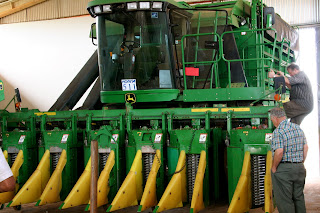Our days in this part of Brazil usually included 2 tours so after the morning spent looking at at pineapple and sugarcane, we headed south of town to another farm. Along the way, we passed over this escarpment, which is a defining geographical feature that influences the amount of rainfall the area receives. The closer you are to the escarpment, the greater the likelihood that you will receive adequate rainfall during the growing season. And that means that prime land is also the most expensive in the area.

This farm is located on prime land - 30,000 hectares of land that is! It was the biggest farm we visited and is owned by the Horito's, a Japanese family. The gate sign was a long way from the actual yard!

In the boardroom, were a number of interesting pictures, including this one taken 10 years ago. The farm has added and opened up lots of new land since this picture was taken. This gives you a good idea of what center pivot irrigation looks like from the air. You can see the farmyard in the center right, which is where our visit started.








Of course we started by seeing the workers accommodations including the laundry room -

and shoe room. When they come in from the fields, all the outer wear is taken off in these areas so the dormitory rooms stay clean.

The bus is parked in front of the farm office where there is a scale for loaded trucks to go over as they depart. Our tour guide's wife worked in the office and their little boy was sleeping in one of the offices - an informal on site daycare!

There was big equipment everywhere including this crop sprayer that was being washed off.

The men in the shop were busy with repairs and retrofits to the planters. I love the natural, rustic feel of this picture.

There were 20 cotton pickers in the yard!! That's a lot of cotton when you think that each load/bale weighs between 10 and 12 thousand pounds! You can see puddles left after the morning rain.

What does every farmer do when he sees a new piece of equipment? You're right! He climbs up to check it out!!


Our next stop was a cotton field -



followed by the soybean fields where the 3 Ontario growers (Steve, Neil and Ed) had a portrait taken.

These soybean plants were seeded in November and were 3 months old. They would be harvested in April, 5 - 6 weeks after our visit.



Corn was the third major crop grown here and Lou and Debbie from Washington State were very interested in it. Our local tour guide, Brian, did an excellent job of answering umpteen questions from our curious group!

This farm employed 14 agronomists, who were responsible for decision making, and 28 agriculture technicians who did most of the tractor driving and crop operations work. I think there were specific teams of people responsible for each of the different crops. It definitely was big business!! But like all of our guides, these men were so friendly and delighted to share their experiences and knowledge with us.


This was a perfect spot for a group picture - out in the fields of Brazil!

What a great trip....so very interesting to learn about another areas business!
ReplyDeleteI love that you are doing this! Can you believe it's been a year already?
ReplyDeleteBTW, I was just looking at your photo-a-day photos and wondering where that Fatburger is.